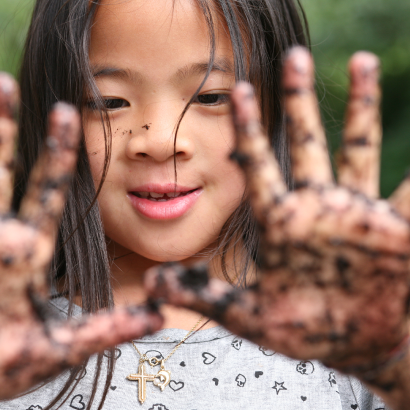
Dirt is a good thing.
Take a live snake into an inner-city school or community center and you may clear the room. I have had this experience several times… but only on the first visit. Oklahoma City has a very popular snake named Moon who is a rock star when she visits the City’s recreation centers. When nature center staff visits the centers, the kids now ask for her by name. She is an excellent ambassador for all snakes, but also for nature. She also serves as an example of how many kids today are disconnected from nature.
Today many people do not have the relationship with nature that previous generations did. There is a lack of intimacy and knowledge of nature that make people uneasy with critters, such as Moon, playing in the dirt and natural areas. However, human beings need nature, not just for basic needs such as food and water, but for our mental and physical well-being. Time in nature can help with depression, attention deficit disorder, decrease blood pressure, decrease stress, reduce childhood asthma and improve overall health.
A bacterium called Mycobacterium vaccae is found in “dirt”. The bacteria may improve moods because it increases serotonin levels. Serotonin levels are associated with depression, aggression, anxiety, obsessive compulsive disorder, bipolar and may influence other health conditions such as irritable bowel and fibromyalgia. Increased serotonin levels may also be associated with increased concentration which helps kids learn. The bacteria may enter the body through inhalation or minor cuts in the skin. So, to enjoy the benefits of increased serotonin and an improved mood you simply need to play in the dirt!
For those unfamiliar with the great outdoors, never fear. You can start in your own backyard! There are a multitude of resources* available to those wishing to start nature education without a nature background. Most conservation organizations have a curriculum that will outline activities step-by-step. It can be even simpler than that, though. You can take a hike through the neighborhood, do an outdoor scavenger hunt, observe the bugs in the cracks of the sidewalk, watch birds nesting in the trees and witness leaves changing colors with the seasons.
Container gardens are a great way to let kids (and adults) play in the dirt when space is tight. Gardens can be made of plastic barrels, wooden pallets or storage tubs. Increase your dose of nature by using plants native to your area to attract native butterflies and birds. You may then choose to try Vermicomposting, which is composting with worms. You simply keep the little critters in a tub and the kids can throw in their scraps from snack. As you become more comfortable with getting your participants outside, you can build your program and expand your adventures!
Or you may simply take your activities outside! Read your book under a shade tree, take your laptop to the park or run outside instead of on a treadmill. By moving your daily activities outside, you will be getting a healthy dose of nature.
So, keep encouraging kids of all ages to get outside and get dirty—it might just be the best thing they do for themselves and their happiness!
Emily Hiatt is a Naturalist for Oklahoma City Parks and Recreation.
NRPA’s Young Professional Network serves NRPA members who are students and young professionals as well as those that are interested in engaging in topics or discussions concerning students and young professionals.
* Resources for nature education include:
- NRPA’s Wildlife Explorers program.
- Many organizations have resources that outline programs. A few notable ones are Project WET, Project WILD, Learning to Hunt (which isn’t just hunting) by Wisconsin DNR, Leopold Education Project, Leave No Trace, Wildlife Habitat Education Program through extension services, and many local nature/conservation groups have developed their own activities.
- The National Wildlife Federation has an excellent online activity finder where you can enter your target demographics.
- Sharing Nature with Children or Sharing the Joy of Nature by Joseph Cornell.
- National Archery in the Schools Program (NASP) and National Fishing in the Schools.
- Local state Game and Fish or Conservation Dept.

